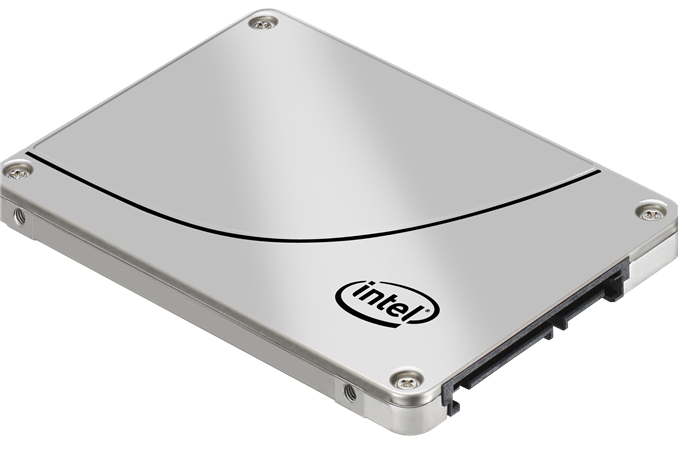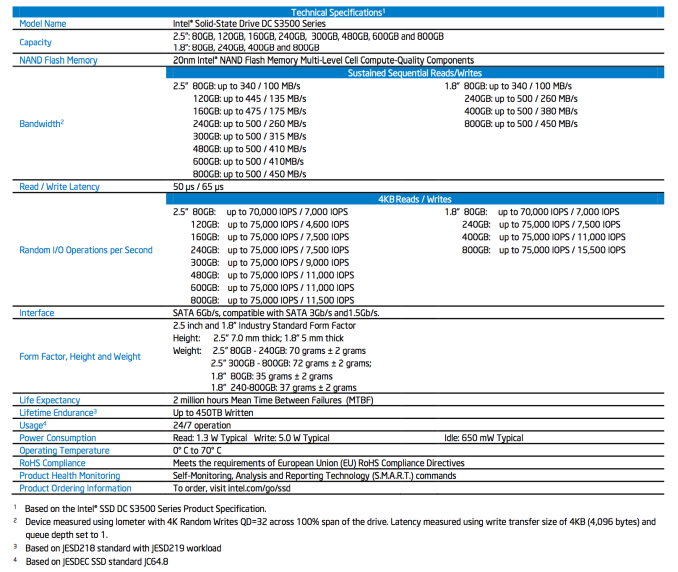Intel SSD DC S3500 Review (480GB): Part 1
by Anand Lal Shimpi on June 11, 2013 6:10 PM EST- Posted in
- Storage
- IT Computing
- SSDs
- Intel
- Datacenter
- Enterprise

Last year Intel introduced its first truly new SSD controller since 2008. Oh how times have changed since then. Intel's original SSD controller design was dual purpose, designed for both consumer and enterprise workloads. Launching first as the brains behind a mainstream Intel SSD, that original controller did a wonderful job of kicking off the SSD revolution that followed. Growing pains and a couple of false starts kept a true successor to Ephraim (Intel's first controller) from ever really surfacing over the next few years.
Last year, Ephraim got a true successor and it came in the form of a very high-end enterprise drive: the Intel SSD DC S3700. Equipped with tons of 25nm HET-MLC NAND, the S3700 officially broke the enterprise addiction to SLC for high endurance drives while raising the bar in all aspects of performance. In addition to the usual considerations however, Intel had a new focus with the S3700: performance consistency.
Due to the nature of NAND flash, there's a lot of background management/cleanup that happens in order to ensure endurance as well as high performance. It's these background management tasks that can dramatically impact performance. I love the cleaning your room analogy because it accurately describes the tradeoffs SSD controller makers have to deal with. Clean early and often and you'll do well. Put off cleaning until later and you'll enjoy tons of free time early but you'll quickly run into a problem. It's an oversimplification, but the latter is what most SSD controllers have done historically, and the former is what Intel always believed in. With the S3700, Intel took it to the next level and built the most consistent performing SSD I'd ever tested.
Performance consistency matters for a couple of reasons. The most obvious is an impact to user experience. Predictable latencies are what you want, otherwise your applications can encounter odd hiccups. In client drives, those hiccups appear as unexpected pauses during application usage. In the enterprise, the manifestation is similar except the user encounters the issue somewhere over the internet rather than locally. The other issue with inconsistent performance really creeps up in massive RAID arrays. With many drives in a RAID array, overall performance is determined by the slowest performing drive. Inconsistent performance, particularly with large downward swings, can result in substantial decrease in the performance of large RAID arrays. The motivation to build a consistently performing SSD is high, but so is the level of difficulty in building such a drive.
Intel had the luxury of being able to start over with the S3700's controller architecture. It moved to a flat indirection table (mapping between LBAs and NAND pages), which incurred a DRAM size penalty but ultimately made it possible to deliver much better performance consistency. The S3700 did amazingly well in our enterprise tests, and produced the most consistent IO consistency curves I'd ever seen. The only downside? Despite being much better priced than the Intel X25-E and SSD 710, the S3700 is still a very expensive drive. The move to a better architecture helped reduce the amount of spare area needed for good performance, which in turn reduced cost, but the S3700 still used Intel's most expensive, highest endurance MLC NAND available (25nm HET-MLC). With the largest versions capable of enduring nearly 15 petabytes of writes, the S3700 was really made for extremely write intensive workloads. The drive performs very well across the board, but if you don't have an extremely write intensive workload you'd be paying for much more than you needed.
We always knew that Intel would build a standard MLC version of the S3700, and today we have that drive: the Intel SSD DC S3500.











54 Comments
View All Comments
oyabun - Wednesday, June 12, 2013 - link
I made the same observation, the Samsung has at a minimum the performance of the Intel drive and then skyrockets.cheeselover - Wednesday, June 12, 2013 - link
umm... isn't it the other way around? 600pro already has overprovisioning at 28% and s3500 has it at 9%.btb - Wednesday, June 12, 2013 - link
No Windows 8 Secure boot support?btb - Wednesday, June 12, 2013 - link
oops typo, meant Microsoft eDrive supportlyeoh - Wednesday, June 12, 2013 - link
Anand, do you have IOPs/latency over time graphs for random reads as well? Or are random reads quite stable and we can derive them from the 4KB random read IO meter scores? I notice the sandforce drives seem to find random reads harder, so I'm wondering if there are any latency spikes for various drives.lucasbakker - Wednesday, June 12, 2013 - link
What about Capacitors on this controller? Why is it that nowadays in reviews I don't see any mention anymore about supercapacitors and data loss when losing power.ShieTar - Wednesday, June 12, 2013 - link
Well, those are enterprise drives, Intel probably assumes that their customers will implement their own emergency power plans in their data centers, so the drives itself don't have to.And on consumer drives, the potential data loss of a power outage are rather acceptable for most people. I've personally experienced one real power outage and one blown fuse over the next 25 years, so that's not really a relevant scenario for my PC buying decisions.
lucasbakker - Wednesday, June 12, 2013 - link
It used to be a big issue in reviews. For databases a capacitor can be pretty important, even when taking emergency power setups in mind. Furthermore, I guess that with laptops sudden power drops are a little bit more common.thomas-hrb - Wednesday, June 12, 2013 - link
Somehow I don't see this making it into too many laptops, and enterprise SAN's etc have power failure protection. I think that it is just a feature that was in the S3700 that they did not disable in this unit, it all helps with the prosumer targeting.zanon - Wednesday, June 12, 2013 - link
Um, Anand? Why no mention of your own research showing how key over provisioning was and the immense difference it could make in performance consistency? The S3500 is significantly more expensive then other prosumer drives like the 840 Pro, Corsair Neutron, etc., and by "significant" I mean the magical "25%". That means that someone could instead choose to get another drive (or multiple other drives) and then assign 25% spare area for each, at which point from your own tests it looks like the S3500 gets SLAUGHTERED.Please do not throw softballs to Intel, they are big boys and can and should be expected to produce competitive, top tier stuff with no asterisks. If for some reason the far higher IOPS with better consistency produced by drives like the Corsair aren't worth the same as the Intel drive, please explain why. If there are other special features being factored in, please mention them. But even for a brief, high level overview this didn't feel like it set the proper context. You spent a great deal of time testing and discussing this stuff in the past, so to suddenly have it vanish from the conversation feels pretty weird.